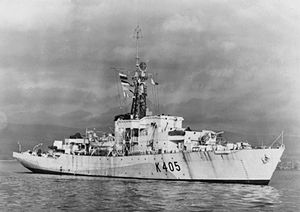HMS Alnwick Castle (K405)

Alnwick Castle in November 1944
|
|
| History | |
|---|---|
|
|
|
| Name: | HMS Alnwick Castle |
| Namesake: | Alnwick Castle |
| Laid down: | 12 June 1943 |
| Launched: | 23 May 1944 |
| Commissioned: | 11 November 1944 |
| Identification: | Pennant number: K405 |
| Fate: | Scrapped in 1958 |
| General characteristics | |
| Class and type: | Castle-class corvette |
| Displacement: | 1,060 tons |
| Length: | 252 ft (77 m) |
| Beam: | 37 ft (11 m) |
| Draught: | 10 ft (3.0 m) |
| Propulsion: | 2 water tube boilers, 1 four cylinder triple expansion steam engine driving a single screw 2,750 hp (2 MW) |
| Speed: | 16.5 knots (30.6 km/h; 19.0 mph) maximum, 10 knots (19 km/h) cruising |
| Range: | 9,500 nautical miles at 10 knots (17,600 km at 19 km/h) |
| Complement: | 112 |
| Sensors and processing systems: |
Radar - Type 272 originally, Sonar - Types 144Q and 147B originally |
| Armament: |
|
HMS Alnwick Castle was a Castle-class corvette of the United Kingdom's Royal Navy. She was named after Alnwick Castle in Northumberland.
She was laid down on 12 June 1943 and launched by George Brown and Company at Greenock in Scotland on 23 May 1944. She was commissioned on 11 November 1944 and served as a convoy escort until the end of the Second World War.
From 20 July 1944 to mid 1945, the Alnwick Castle was commanded by Herbert Arthur Stonehouse (DSO and bar).
After the war, she was placed in reserve at Portsmouth where she remained until she was transferred to the reserve at Harwich in 1950 and thence to West Hartlepool until 1958 when she was scrapped. She arrived at Gateshead for scrapping on 9 December 1958.
...
Wikipedia
